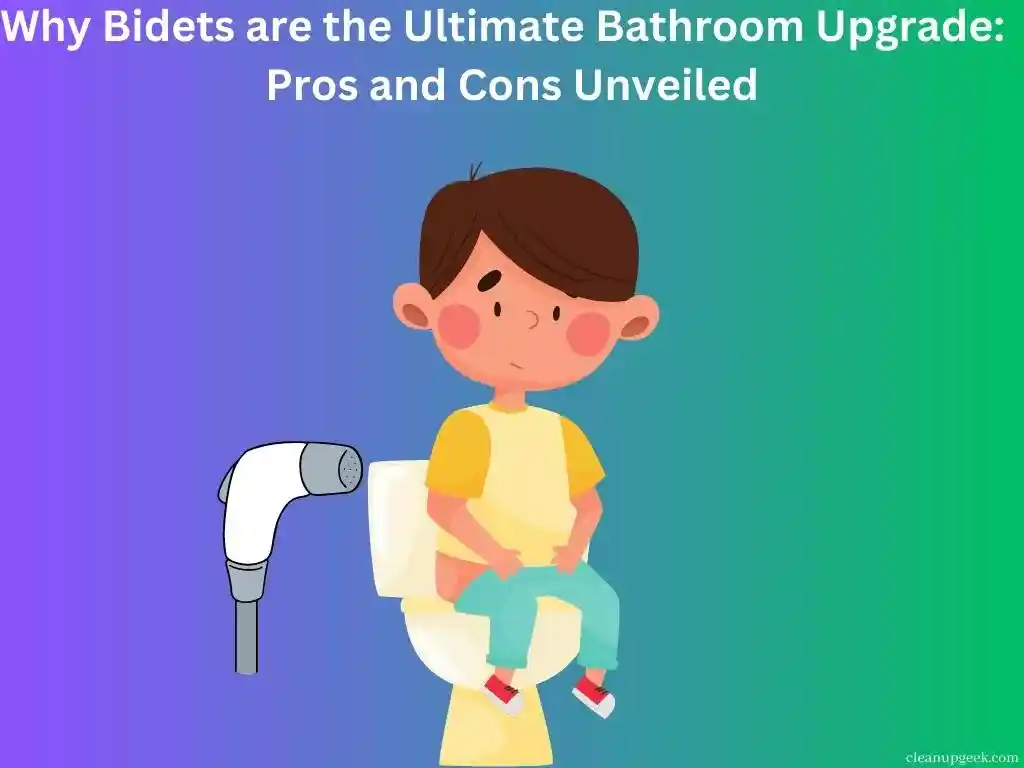Ever pondered switching up your bathroom routine with a bidet? These sanitation devices have earned their reputation for superior hygiene and environmental benefits.
This comprehensive article dives deep into the pros and cons of bidets, serving as a guide for everyone striving to improve their toilet experience.
Ready to explore more? Let’s cleanse those doubts away!
Key Notes
- Bidets offer superior hygiene compared to toilet paper, reducing the risk of bacteria transmission and promoting better personal health outcomes.
- Using a bidet is environmentally friendly as it reduces the need for excessive toilet paper usage, leading to decreased deforestation and waste production.
- Bidets are beneficial for individuals with various medical conditions such as hemorrhoids or limited mobility, providing gentle and soothing cleanliness without causing discomfort.
- Compact bidet versions are available for small bathrooms, offering all the benefits of a standard bidet in a more space-saving design.
- Handheld bidets provide flexibility, ease of use, and cost-effectiveness while not requiring electricity for operation.
- Some potential cons include an adjustment period when transitioning from toilet paper to using a bidet and possible wetting of clothes if not careful during use.
- Standalone bidets may require more bathroom space and separate plumbing lines for installation.
- Uneven nozzles on certain models can pose infection risks in females if not properly cleaned or maintained.
The Advantages of Using a Bidet

Using a bidet offers numerous benefits such as being more hygienic than toilet paper, better for the environment, suitable for people with various medical conditions, and compact versions available for limited bathroom space.
1. More hygienic than toilet paper
As one of the key advantages, bidets offer a level of cleanliness that traditional toilet paper simply can’t achieve. Through gentle yet effective water streams, they aid in providing a thorough clean-up after using the restroom – often without even requiring any physical contact at all.
This significantly reduces the chance of bacteria transmission from hand to sensitive areas encountered with ordinary toilet paper usage. Notably, several studies suggest that regular bidet use could promote better personal hygiene and health outcomes while potentially lowering the risk for certain conditions such as hemorrhoids and anal fissures.
Switching to a bidet system can therefore lead to improved bathroom hygiene standards and sanitary habits—a boon for cleaning enthusiasts aiming for optimal domestic cleanliness.
2. Better for the environment
Using a bidet is not only beneficial for personal hygiene, but it also has positive impacts on the environment. Traditional toilet paper production involves cutting down trees and contributes to deforestation.
In contrast, bidets use water to clean, eliminating the need for excessive toilet paper usage. According to research, the average person uses about 57 sheets of toilet paper daily, which adds up to a significant amount of waste over time.
By switching to a bidet, you can significantly reduce your carbon footprint and help conserve natural resources. Furthermore, bidets decrease the strain on wastewater treatment facilities since they don’t require large amounts of paper waste to be processed.
This makes them a more sustainable and eco-friendly option for those who are conscious of their environmental impact.
Additionally, many bidets come with adjustable pressure settings that allow users to control the amount of water used during each wash. This ensures that no more water is wasted than necessary while still maintaining proper cleanliness.
3. Good for people with various medical conditions
Bidets offer significant benefits for individuals with various medical conditions. For those suffering from hemorrhoids, anal fissures, or arthritis, the use of toilet paper can be incredibly uncomfortable and even painful.
Bidets provide a gentle and soothing clean that helps to alleviate discomfort in these sensitive areas.
Additionally, bidets are highly beneficial for individuals with mobility issues who may struggle with traditional toilet hygiene. The ease of use and thorough cleaning provided by bidets eliminate the need for excessive bending or twisting, making it an ideal solution for those with limited mobility.
Furthermore, bidets are recommended by doctors for their hygienic advantages. Traditional toilet paper can sometimes be abrasive and irritating to delicate skin, while bidet usage ensures a more thorough clean without causing any friction or irritation.
4. Compact versions available for limited bathroom space
Compact versions of bidets are a great option for bathrooms with limited space. These smaller bidet models are designed to fit comfortably in small bathrooms without taking up too much room.
They offer all the benefits of a standard bidet, such as improved hygiene and environmental friendliness, but in a more compact and convenient package. So even if you have a small bathroom, you can still enjoy the soothing clean that bidets provide without compromising on space.
Plus, some handheld bidets don’t require electricity, making them an even more practical choice for those with limited bathroom space.
5. Handheld bidet provides flexibility and ease of use
One of the major advantages of using a handheld bidet is the flexibility and ease of use it offers. With a handheld bidet, you have full control over where and how you direct the water stream for cleaning.
This allows you to customize your cleaning experience according to your personal preferences and needs. Whether you want a gentle spray or a more powerful cleanse, a handheld bidet gives you that flexibility.
In addition, using a handheld bidet is incredibly easy. Most models come with simple controls that allow you to adjust the water pressure and temperature effortlessly. The compact design also makes them convenient to hold and maneuver, ensuring that every nook and cranny can be thoroughly cleaned.
Handheld bidets are not only practical but also affordable compared to standalone bidets or toilet seat attachments. They require no electricity for operation, making them an economical choice in terms of energy consumption as well.
6. No electricity is required for handheld bidets
Handheld bidets are an excellent option for those who prefer a more portable and flexible solution. One of the significant advantages is that they do not require electricity to operate, making them energy-efficient and cost-effective.
This feature is especially beneficial during power outages or in areas with unreliable electrical supply.
Without the need for electricity, handheld bidets can be easily used by anyone, regardless of their bathroom setup. They typically attach directly to the existing toilet water supply line, providing a convenient way to clean oneself after using the toilet without relying on toilet paper alone.
Moreover, handheld bidets offer customizable water pressure through adjustable nozzles and sprays. This allows users to find the perfect setting that suits their hygiene needs and personal preferences while maintaining comfort during use.
The Disadvantages of Using a Bidet

Using a bidet may take some getting used to, and there is a risk of wetting clothes if one is not careful during use. Standalone bidets also require more space in the bathroom and separate plumbing lines, which might be inconvenient for some households.
Additionally, first-time users may find it tricky to navigate seat bidets, while uneven nozzles on certain models can potentially lead to infections in females. Electric bidets are rendered ineffective during power outages as well.
1. May take some getting used to
Using a bidet may take some getting used to, especially for those who have never tried it before. It’s a different experience compared to using toilet paper, and it might feel strange or unfamiliar at first.
However, many people find that once they get the hang of it, they prefer using a bidet for its refreshing and hygienic benefits. It’s important to remember that practice makes perfect, so give yourself some time to adjust, and don’t be discouraged if you don’t feel comfortable right away.
With patience and persistence, you’ll soon discover the soothing clean feeling that comes with using a bidet.
2. Standalone bidets require more space and separate plumbing lines
Standalone bidets offer a unique and luxurious way to improve personal hygiene, but it’s important to consider the space and plumbing requirements before installation. These bidets typically take up more room in the bathroom compared to other options, which may pose a challenge for those with limited space.
Additionally, standalone bidets require separate plumbing lines, adding complexity and potentially increasing installation costs. However, if you have enough space and are willing to invest in the necessary renovations, standalone bidets can provide an enhanced cleansing experience that goes beyond what traditional toilets can offer.
3. Risk of wetting clothes if not careful
One potential downside of using a bidet is the risk of accidentally wetting your clothes if you’re not careful. When adjusting the water pressure or positioning yourself on the bidet seat, there is a possibility of splashing water onto your clothing.
This can be particularly frustrating if you’re in a hurry or trying to maintain a dry outfit.
To mitigate this risk, it’s important to take small steps and make gradual adjustments when using a bidet. Start with lower water pressure settings until you get used to the sensation and ensure proper alignment with the spray nozzle.
Additionally, some bidets offer adjustable nozzles that allow you to control both position and angle for more accurate cleaning while minimizing any potential splashing.
4. Seat bidets can be tricky for first-time users
Using a seat bidet for the first time can be a bit challenging. While seat bidets offer convenience and added cleanliness, they may take some getting used to. The positioning of the spray nozzle and adjusting water pressure can require a little practice before finding the perfect settings for your comfort.
It’s important to familiarize yourself with the controls and experiment with different angles to ensure an effective clean without any discomfort. However, once you get the hang of it, you’ll appreciate the soothing and thorough cleaning that a seat bidet provides.
Remember to start with gentle water pressure and gradually increase it as needed.
5. Uneven nozzles may lead to infections in females
Uneven nozzles on bidets may pose a potential risk for infections in females. The uneven distribution of water during cleaning can lead to the spread of bacteria, especially if not thoroughly cleaned or sanitized.
It is important to ensure that bidet nozzles are properly maintained and kept clean to minimize the risk of any unwanted infections. Regular cleaning and maintenance of the bidet can help prevent these issues from occurring and maintain a hygienic bathroom environment.
6. Electric bidets don’t work during power outages
During power outages, electric bidets are rendered useless. This is an important consideration for those who live in areas prone to electrical disruptions or for anyone concerned about maintaining proper hygiene during such situations.
Unlike non-electric bidets or handheld options, electric bidets rely on electricity to function properly. It’s worth noting that some people may choose to invest in battery-operated backup systems for their electric bidet to ensure uninterrupted use even during power outages.
Nonetheless, it’s a good idea to be aware of this limitation and have alternative hygiene measures in place when needed.
Considerations for Bidet Purchase
When considering purchasing a bidet, it’s important to take into account your personal needs and preferences. Whether you opt for a standalone bidet or a handheld version, make sure to weigh the pros and cons of each before making your decision.
To explore all aspects of bidet usage and learn more about how it can benefit your hygiene routine, keep reading!
Price variations between standalone bidets and handheld bidets
When it comes to purchasing a bidet, one of the key factors to consider is cost. Between standalone and handheld bidets, there’s a significant difference in price.
| Type of Bidet | Average Cost |
|---|---|
| Standalone Bidet | These luxury items can often cost between $400 and $1500, depending on the brand and specifications. The price can go up further if you need to make renovations for installation as standalone bidets usually require more space and separate plumbing lines. |
| Handheld Bidet | Handheld bidets, on the other hand, are more affordable, typically ranging from $30 to $100. They do not require electricity and can fit in even the smallest of bathrooms, making them a cost-effective and convenient option. |
In conclusion, whether you choose a standalone or handheld bidet will largely depend on your budget, the available bathroom space, and your personal hygiene preferences.
Handheld bidets are more affordable options
Handheld bidets are a cost-effective choice when considering bidet options. Compared to standalone bidets, handheld bidets are typically more affordable, making them an attractive option for those on a budget.
These portable devices can easily be attached to your existing toilet, eliminating the need for separate plumbing lines or additional bathroom renovations. Another advantage of handheld bidets is their simplicity – they require no electricity and are easy to operate with just a simple squeeze or press of a button.
So if you’re looking for an economical way to enhance your bathroom hygiene routine without breaking the bank, consider investing in a handheld bidet.
Choosing the right bidet based on personal needs and preferences
Selecting the perfect bidet for your needs and preferences is essential to ensure a satisfying bathroom experience. Consider factors such as budget, available space in your bathroom, and desired functionalities when choosing between standalone bidets and handheld bidets.
Standalone bidets are ideal if you have ample space and are willing to undertake minor renovations for installation. On the other hand, handheld bidets provide a more affordable option with no electricity required, making them suitable for those on a tighter budget or limited bathroom space.
Whether you prioritize convenience, flexibility, or eco-friendliness, finding the right bidet tailored to your specific requirements will enhance your overall toilet hygiene routine.
Expert Opinions on Bidet Usage

Experts in the field emphasize the numerous benefits of bidet usage, highlighting improved personal hygiene and a more thorough clean compared to traditional toilet paper.
Health experts weigh in on the benefits of bidets
Experts in the field of health have shared their insights on the numerous benefits of bidets. One major advantage that they highlight is improved hygiene compared to using traditional toilet paper.
Bidets offer a more thorough and completely clean, which can be particularly beneficial for individuals with sensitive areas or conditions such as hemorrhoids or anal fissures. Additionally, bidets are considered to be more environmentally friendly since they reduce the need for excessive use of abrasive toilet paper.
Furthermore, bidets provide soothing relief for those with arthritis or mobility issues who may struggle with conventional cleaning methods. It’s clear that bidets offer a host of advantages when it comes to maintaining personal cleanliness and well-being in the bathroom.
Doctors’ perspective on bidet hygiene
From a doctor’s perspective, bidets are highly regarded for their hygienic benefits. Traditional wiping with toilet paper can often be abrasive and irritating to sensitive areas. Bidets, on the other hand, provide a soothing clean that is gentle on the skin and helps to prevent conditions like hemorrhoids and anal fissures.
Furthermore, bidets offer a more thorough cleanse compared to toilet paper alone. This is especially important for individuals with certain medical conditions or mobility issues that may make proper hygiene difficult.
By washing with water instead of relying solely on toilet paper, bidet users can ensure a higher level of cleanliness.
Doctors also highlight the potential drawbacks of using bidets. One concern is the risk of infection in females if the nozzle of an unevenly designed bidet sprays into the vagina instead of cleansing only external areas.
It’s crucial to choose a bidet with an adjustable nozzle or one specifically designed for female use to mitigate this risk.
Frequently Asked Questions

1. What are the pros of using a bidet?
Using a bidet offers several advantages, including improved hygiene, reduced toilet paper usage, and soothing relief for those with certain medical conditions or sensitivities.
2. Are bidets suitable for everyone?
Bidets can be used by individuals of all ages and abilities. They offer a gentle and effective cleaning option that is particularly helpful for people with mobility issues, arthritis, or other physical limitations.
3. What are the cons of using a bidet?
Some potential drawbacks to consider include the initial cost of purchasing and installing a bidet unit, the need for additional space in your bathroom, and potential discomfort if not adjusted or used correctly.
4. Do bidets save water compared to traditional toilet paper use?
Yes, bidets are considered more environmentally friendly than relying solely on toilet paper. While they use water during operation, the overall water consumption is typically lower compared to manufacturing and disposing of large quantities of toilet paper.
Conclusion and final thoughts 💭
In conclusion, the pros and cons of using a bidet should be carefully considered before making a decision. While bidets offer numerous benefits such as improved hygiene, environmental friendliness, and suitability for individuals with medical conditions or limited bathroom space, there are also potential drawbacks to keep in mind.
These include the need for adjustment period, higher installation costs for standalone bidets, possible wetting of clothes if not careful during use, and concerns about bacterial contamination.
Ultimately, it is important to weigh these factors and choose the right type of bidet that meets your personal needs and preferences.















